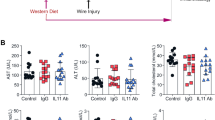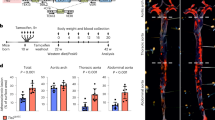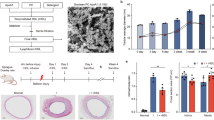Abstract
Early growth response factor-1 (Egr-1) is a transcription factor that is rapidly activated after vascular injury and thus might contribute to vascular proliferation and inflammation. We hypothesized that Egr-1 might therefore be a therapeutic target against restenosis. Hypercholesterolemic rabbits were intraluminally administered synthetic DNA as a ‘decoy’ against Egr-1 immediately after carotid artery balloon injury. Efficient transfection was confirmed by the delivery of a fluorescence-labeled decoy. Gel mobility-shift assay showed increased Egr-1 activity after balloon injury and its prevention by Egr-1 decoy transfection in vivo. Egr-1 decoy transfection attenuated early inflammation and proliferation and later neointimal hyperplasia. In addition, Egr-1 decoy transfection reduced gene expression and protein production of Egr-1-dependent genes such as platelet-derived growth factor-B, transforming growth factor-β1, and monocyte chemoattractant protein-1. The Egr-1 pathway has an essential role in the pathogenesis of neointimal hyperplasia after balloon injury in hypercholesterolemic rabbits. This decoy strategy is a potential practical form of therapy for human restenosis.
This is a preview of subscription content, access via your institution
Access options
Subscribe to this journal
Receive 12 print issues and online access
$259.00 per year
only $21.58 per issue
Buy this article
- Purchase on Springer Link
- Instant access to full article PDF
Prices may be subject to local taxes which are calculated during checkout





Similar content being viewed by others

References
Ross R . Atherosclerosis – an inflammatory disease. N Engl J Med 1999; 340: 115–126.
Lusis AJ . Atherosclerosis. Nature 2000; 407: 233–241.
Glass CK, Witztum JL . Atherosclerosis. The road ahead. Cell 2001; 104: 503–516.
Libby P, Ganz P . Restenosis revisited – new targets, new therapies. N Engl J Med 1997; 337: 418–419.
Topol EJ, Serruys PW . Frontiers in interventional cardiology. Circulation 1998; 98: 1802–1820.
Morice MC et al. A randomized comparison of a sirolimus-eluting stent with a standard stent for coronary revascularization. N Engl J Med 2002; 346: 1773–1780.
Sousa JE et al. Sustained suppression of neointimal proliferation by sirolimus-eluting stents: one-year angiographic and intravascular ultrasound follow-up. Circulation 2001; 104: 2007–2011.
Khachigian LM, Collins T . Inducible expression of Egr-1-dependent genes. A paradigm of transcriptional activation in vascular endothelium. Circ Res 1997; 81: 457–461.
Khachigian LM, Lindner V, Williams AJ, Collins T . Egr-1-induced endothelial gene expression: a common theme in vascular injury. Science 1996; 271: 1427–1431.
Khachigian LM . Catalytic DNAs as potential therapeutic agents and sequence-specific molecular tools to dissect biological function. J Clin Invest 2000; 106: 1189–1195.
McCaffrey TA et al. High-level expression of Egr-1 and Egr-1-inducible genes in mouse and human atherosclerosis. J Clin Invest 2000; 105: 653–662.
Kim S et al. Angiotensin II type 1 receptor blockade inhibits the expression of immediate-early genes and fibronectin in rat injured artery. Circulation 1995; 92: 88–95.
Santiago FS et al. New DNA enzyme targeting Egr-1 mRNA inhibits vascular smooth muscle proliferation and regrowth after injury. Nat Med 1999; 5: 1438.
Lowe HC et al. Catalytic oligodeoxynucleotides define a key regulatory role for early growth response factor-1 in the porcine model of coronary in-stent restenosis. Circ Res 2001; 89: 670–677.
Morishita R, Higaki J, Tomita N, Ogihara T . Application of transcription factor ‘decoy’ strategy as means of gene therapy and study of gene expression in cardiovascular disease. Circ Res 1998; 82: 1023–1028.
Mann MJ, Dzau VJ . Therapeutic applications of transcription factor decoy oligonucleotides. J Clin Invest 2000; 106: 1071–1075.
Kitamoto S et al. Increased activity of nuclear factor-kappaB participates in cardiovascular remodeling induced by chronic inhibition of nitric oxide synthesis in rats. Circulation 2000; 102: 806–812.
Yu JC et al. Efficacy of the novel selective platelet-derived growth factor receptor antagonist CT52923 on cellular proliferation, migration, and suppression of neointima following vascular injury. J Pharmacol Exp Ther 2001; 298: 1172–1178.
Deguchi J et al. Targeting endogenous platelet-derived growth factor B-chain by adenovirus-mediated gene transfer potently inhibits in vivo smooth muscle proliferation after arterial injury. Gene Therapy 1999; 6: 956–965.
Yamamoto K et al. Ribozyme oligonucleotides against transforming growth factor-beta inhibited neointimal formation after vascular injury in rat model: potential application of ribozyme strategy to treat cardiovascular disease. Circulation 2000; 102: 1308–1314.
Smith JD et al. Soluble transforming growth factor-beta type II receptor inhibits negative remodeling, fibroblast transdifferentiation, and intimal lesion formation but not endothelial growth. Circ Res 1999; 84: 1212–1222.
Mori E et al. Essential role of monocyte chemoattractant protein-1 in development of restenotic changes (neointimal hyperplasia and constrictive remodeling) after balloon angioplasty in hypercholesterolemic rabbits. Circulation 2002; 105: 2905–2910.
Usui M et al. Anti-monocyte chemoattractant protein-1 gene therapy inhibits restenotic changes (neointimal hyperplasia) after balloon injury in rats and monkeys. FASEB J 2002; 16: 1838–1840.
Egashira K et al. Importance of monocyte chemoattractant protein-1 pathway in neointimal hyperplasia after periarterial injury in mice and monkeys. Circ Res 2002; 90: 1167–1172.
Yoshimura S et al. Inhibition of intimal hyperplasia after balloon injury in rat carotid artery model using cis-element ‘decoy’ of nuclear factor-kappaB binding site as a novel molecular strategy. Gene Therapy 2001; 8: 1635–1642.
Kume M et al. Administration of a decoy against the activator protein-1 binding site suppresses neointimal thickening in rabbit balloon-injured arteries. Circulation 2002; 105: 1226–1232.
Usui M et al. Important role of local angiotensin II activity mediated via type 1 receptor in the pathogenesis of cardiovascular inflammatory changes induced by chronic blockade of nitric oxide synthesis in rats. Circulation 2000; 101: 305–310.
Acknowledgements
This study was supported by Grants-in-Aid for Scientific Research (14657172, 14207036) from the Ministry of Education, Science, and Culture, Tokyo, Japan, by Health Science Research Grants (Comprehensive Research on Aging and Health, and Research on Translational Research) from the Ministry of Health Labor and Welfare, Tokyo, Japan, and by the Program for Promotion of Fundamental Studies in Health Sciences of the Organization for Pharmaceutical Safety and Research, Tokyo, Japan.
Author information
Authors and Affiliations
Rights and permissions
About this article
Cite this article
Ohtani, K., Egashira, K., Usui, M. et al. Inhibition of neointimal hyperplasia after balloon injury by cis-element ‘decoy’ of early growth response gene-1 in hypercholesterolemic rabbits. Gene Ther 11, 126–132 (2004). https://doi.org/10.1038/sj.gt.3302153
Received:
Accepted:
Published:
Issue Date:
DOI: https://doi.org/10.1038/sj.gt.3302153
Keywords
This article is cited by
-
Synthetic protein-binding DNA sponge as a tool to tune gene expression and mitigate protein toxicity
Nature Communications (2020)
-
Early growth response-1 in the pathogenesis of cardiovascular disease
Journal of Molecular Medicine (2016)
-
Conditional Expression of the Type 2 Angiotensin II Receptor in Mesenchymal Stem Cells Inhibits Neointimal Formation After Arterial Injury
Journal of Cardiovascular Translational Research (2014)
-
A novel chimeric promoter that is highly responsive to hypoxia and metals
Gene Therapy (2006)


